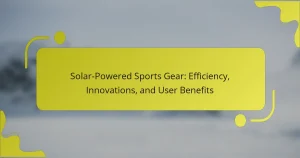Biodegradable golf balls offer a sustainable alternative to traditional options, balancing performance with environmental responsibility. They perform comparably in terms of distance and accuracy while decomposing within months, reducing pollution. Innovations in materials enhance their durability and playability, although some players may notice slight differences in feel. Understanding the environmental impact and proper usage can guide golfers in making informed choices.

How do biodegradable golf balls perform compared to traditional options?
Biodegradable golf balls generally perform similarly to traditional options but offer significant environmental advantages. They are designed to break down naturally, reducing long-term pollution. Performance metrics, such as distance and feel, have improved with innovations in materials. Many players find that biodegradable options deliver comparable accuracy and control, making them a viable alternative. However, some users report slight differences in durability, especially in wet conditions. Overall, the choice between biodegradable and traditional balls often hinges on environmental priorities versus performance preferences.
What are the key performance metrics of biodegradable golf balls?
The key performance metrics of biodegradable golf balls include durability, distance, spin rate, and degradation time. These metrics determine how well the balls perform on the course while also considering their environmental impact.
| Metric | Value |
|——————|———————|
| Durability | Comparable to traditional balls |
| Distance | Up to 300 yards |
| Spin Rate | Similar to standard balls |
| Degradation Time | 3 to 5 years |
How does material composition affect performance?
Material composition significantly influences the performance of biodegradable golf balls. Different materials affect factors like distance, spin, and durability. For instance, plant-based polymers can enhance flight characteristics while remaining environmentally friendly. Innovations in material science aim to balance performance with sustainability, ensuring these golf balls meet player expectations.
Which brands lead in performance metrics?
Top brands leading in biodegradable golf ball performance include Titleist, Srixon, and EcoGolf. These brands focus on metrics such as durability, distance, and environmental impact. Titleist’s biodegradable balls feature a unique core that enhances performance while reducing ecological footprint. Srixon emphasizes consistency and feel, making their products popular among players. EcoGolf stands out with innovative materials that break down naturally without harming ecosystems.

What is the environmental impact of biodegradable golf balls?
Biodegradable golf balls have a significantly lower environmental impact compared to traditional plastic balls. They decompose within a few months to years, reducing pollution in water bodies and landscapes. These balls are typically made from natural materials, which contribute to soil health upon degradation. In contrast, conventional golf balls can take decades to break down, releasing harmful toxins. As a result, the adoption of biodegradable options promotes sustainable golfing practices and minimizes ecological harm.
How do biodegradable golf balls decompose in various environments?
Biodegradable golf balls decompose through various environments, primarily influenced by factors like moisture, temperature, and microbial activity. In soil, they break down within weeks to months, while in water, decomposition may take longer due to lower microbial presence. Sunlight exposure accelerates degradation, especially in composting conditions. These factors collectively impact the performance and environmental benefits of biodegradable golf balls.
What are the benefits of using biodegradable materials in golf?
Biodegradable materials in golf, particularly biodegradable golf balls, offer significant benefits. They reduce environmental impact by decomposing naturally, minimizing pollution. Additionally, they enhance player experience with comparable performance to traditional options. Innovations in materials improve durability and playability, making them a viable alternative.
Which studies support the environmental advantages of biodegradable golf balls?
Research indicates that biodegradable golf balls significantly reduce environmental impact compared to traditional options. Studies show that these balls decompose within a few months in natural conditions, minimizing plastic pollution in water bodies. For instance, a study published in the Journal of Environmental Management found that biodegradable materials break down 80% faster than conventional plastics. Furthermore, field tests demonstrate that biodegradable golf balls perform similarly to standard balls, making them a viable choice for eco-conscious players. These findings support the transition to more sustainable golfing practices.

What innovations are shaping the future of biodegradable golf balls?
Innovations in biodegradable golf balls focus on enhancing performance while minimizing environmental impact. Key advancements include the use of plant-based materials and improved degradation rates. For example, some manufacturers are developing balls that break down within a few months in natural conditions. These innovations aim to maintain playability while reducing plastic waste in ecosystems. Enhanced durability and consistent performance metrics are also being prioritized to satisfy both golfers and environmental standards.
How are manufacturers improving the design and materials?
Manufacturers are enhancing biodegradable golf balls by using innovative materials and designs. New materials like plant-based polymers and natural rubber improve performance while reducing environmental impact. Advanced manufacturing techniques allow for better durability and playability, ensuring these eco-friendly options meet or exceed traditional golf ball standards.
What role does technology play in enhancing biodegradability?
Technology significantly enhances biodegradability by improving material composition and processing methods. Innovations like biopolymers and advanced manufacturing techniques create golf balls that break down faster in natural environments. These technologies reduce environmental impact, aligning with sustainable practices. For example, some biodegradable golf balls use plant-based materials that decompose within a few months, unlike traditional balls that can last for hundreds of years. This shift not only promotes eco-friendliness but also meets the growing consumer demand for sustainable sporting goods.
Which emerging brands are pushing the boundaries of innovation?
Emerging brands in biodegradable golf balls are significantly innovating the market. Brands such as EcoGolf, Biodegradable Golf, and Green Tee are leading this charge with unique materials and designs that enhance performance while minimizing environmental impact.
EcoGolf utilizes a corn-based polymer that decomposes within three years, setting a new standard for sustainability. Biodegradable Golf focuses on creating balls that maintain traditional performance metrics, ensuring golfers do not sacrifice quality for eco-friendliness. Green Tee’s innovation lies in their unique packaging, which is entirely compostable, further reducing waste.
These brands exemplify how innovation in biodegradable golf balls can align performance with environmental responsibility, appealing to a growing audience of eco-conscious consumers.

What challenges do consumers face when choosing biodegradable golf balls?
Consumers face several challenges when choosing biodegradable golf balls, including performance trade-offs, limited availability, and varying environmental claims. Performance may differ from traditional balls, affecting distance and accuracy. Availability can be constrained, as not all retailers carry these products. Additionally, consumers often encounter conflicting information about biodegradability standards and certifications, making it difficult to assess true environmental impact.
How do price points compare with traditional golf balls?
Biodegradable golf balls generally have a similar price range to traditional golf balls, often varying based on brand and performance features. Traditional golf balls typically range from $20 to $50 per dozen, while biodegradable options may start around $25 and go up to $60, depending on their unique attributes like eco-friendliness and performance metrics. The investment in biodegradable options reflects their innovative materials designed for environmental sustainability, appealing to eco-conscious consumers.
What misconceptions exist about the performance of biodegradable options?
Many misconceptions exist about biodegradable golf balls, particularly regarding their performance and environmental impact. Some believe these balls do not perform as well as traditional options. However, advancements in materials have led to improved aerodynamics and distance comparable to non-biodegradable balls. Others worry that biodegradable balls disintegrate too quickly, but most are designed to last through multiple rounds while safely breaking down in the environment. Additionally, some think biodegradable options are more expensive, yet prices are becoming competitive as innovations expand. Understanding these factors can help players make informed choices.
How can consumers identify quality biodegradable golf balls?
Consumers can identify quality biodegradable golf balls by examining their materials, certifications, and performance metrics. Look for balls made from plant-based materials that break down naturally. Certifications like ASTM D6400 or EN 13432 indicate compliance with biodegradability standards. Performance metrics, such as distance and feel, should match traditional balls. Additionally, consider brands that prioritize environmental impact and provide transparent information about their manufacturing processes.

What are the best practices for using biodegradable golf balls?
To effectively use biodegradable golf balls, prioritize proper selection, storage, and disposal. Choose high-quality biodegradable options designed for durability and performance. Store them in a cool, dry place to maintain integrity. After use, dispose of them in compost or designated biodegradable waste systems to maximize their environmental benefits.
How should biodegradable golf balls be stored and handled?
Biodegradable golf balls should be stored in a cool, dry place away from direct sunlight and moisture. Proper handling includes avoiding sharp objects that could damage the surface. Store them in their original packaging to maintain integrity. This ensures optimal performance and longevity.
What tips can improve the lifespan of biodegradable golf balls?
To improve the lifespan of biodegradable golf balls, store them in a cool, dry place and avoid exposure to direct sunlight. Regularly inspect for damage and use them in less abrasive conditions. Choose high-quality brands known for durability.
What common mistakes should golfers avoid with biodegradable options?
Golfers should avoid common mistakes such as choosing low-quality biodegradable balls, neglecting local environmental regulations, and underestimating performance differences. Selecting poorly made biodegradable options can lead to inconsistent play and environmental harm. Always research product certifications to ensure compliance with ecological standards. Additionally, be aware that biodegradable balls can have varying dissolution rates, impacting their longevity on the course.




